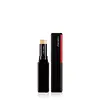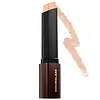Shiseido Synchro Skin Correcting Gelstick Concealer Versus Hourglass Cosmetics Hourglass Vanish Seamless Foundation Stick
What's inside
What's inside
 Key Ingredients
Key Ingredients

 Benefits
Benefits

 Concerns
Concerns

 Ingredients Side-by-side
Ingredients Side-by-side

Hydrogenated Polydecene
EmollientCI 77891
Cosmetic ColorantCI 77492
Cosmetic ColorantKaolin
AbrasiveMica
Cosmetic ColorantCyclopentasiloxane
EmollientDiphenylsiloxy Phenyl Trimethicone
Skin ConditioningCI 77491
Cosmetic ColorantParaffin
PerfumingLithium Magnesium Sodium Silicate
AbsorbentSorbitan Sesquiisostearate
EmulsifyingPolyethylene
AbrasiveCI 77499
Cosmetic ColorantCI 77120
Cosmetic ColorantGlycerin
HumectantDimethicone/Vinyl Dimethicone Crosspolymer
Skin ConditioningCopernicia Cerifera Wax
Microcrystalline Wax
Emulsion StabilisingWater
Skin ConditioningIsododecane
EmollientPhenoxyethanol
PreservativePEG-10 Dimethicone
Skin ConditioningPolysilicone-2
Hydrogenated Polyisobutene
EmollientAluminum Hydroxide
EmollientSynthetic Fluorphlogopite
Disteardimonium Hectorite
StabilisingEthylene/Propylene/Styrene Copolymer
Simethicone
EmollientButylene Glycol
HumectantPropylene Carbonate
SolventTocopherol
AntioxidantAgar
MaskingNacre Powder
AbrasivePolymethylsilsesquioxane
Polyquaternium-51
Skin ConditioningStearic Acid
CleansingTriethoxysilylethyl Polydimethylsiloxyethyl Dimethicone
Skin ConditioningButylene/Ethylene/Styrene Copolymer
Thymus Serpyllum Extract
Skin ConditioningAlumina
AbrasiveSericin
Skin ConditioningSodium Acetylated Hyaluronate
HumectantBHT
AntioxidantCitric Acid
BufferingPotassium Sorbate
PreservativeHydrogenated Polydecene, CI 77891, CI 77492, Kaolin, Mica, Cyclopentasiloxane, Diphenylsiloxy Phenyl Trimethicone, CI 77491, Paraffin, Lithium Magnesium Sodium Silicate, Sorbitan Sesquiisostearate, Polyethylene, CI 77499, CI 77120, Glycerin, Dimethicone/Vinyl Dimethicone Crosspolymer, Copernicia Cerifera Wax, Microcrystalline Wax, Water, Isododecane, Phenoxyethanol, PEG-10 Dimethicone, Polysilicone-2, Hydrogenated Polyisobutene, Aluminum Hydroxide, Synthetic Fluorphlogopite, Disteardimonium Hectorite, Ethylene/Propylene/Styrene Copolymer, Simethicone, Butylene Glycol, Propylene Carbonate, Tocopherol, Agar, Nacre Powder, Polymethylsilsesquioxane, Polyquaternium-51, Stearic Acid, Triethoxysilylethyl Polydimethylsiloxyethyl Dimethicone, Butylene/Ethylene/Styrene Copolymer, Thymus Serpyllum Extract, Alumina, Sericin, Sodium Acetylated Hyaluronate, BHT, Citric Acid, Potassium Sorbate
Phenyl Trimethicone
Skin ConditioningC12-15 Alkyl Ethylhexanoate
EmollientCaprylic/Capric Triglyceride
MaskingEthylhexyl Methoxycinnamate
UV AbsorberEuphorbia Cerifera Wax
Ceresin
Emulsion StabilisingPolyethylene
AbrasivePentylene Glycol
Skin ConditioningMicrocrystalline Wax
Emulsion StabilisingPolyglyceryl-2 Triisostearate
EmulsifyingVp/Hexadecene Copolymer
Methyl Methacrylate Crosspolymer
1,2-Hexanediol
Skin ConditioningAluminum Hydroxide
EmollientBHT
AntioxidantCaprylyl Glycol
EmollientDimethicone
EmollientEthylhexylglycerin
Skin ConditioningIllicium Verum Fruit Extract
PerfumingIsostearyl Alcohol
EmollientLauryl Laurate
Skin ConditioningLauryl PEG/PPG-18/18 Methicone
Skin ConditioningMacadamia Seed Oil Polyglyceryl-6 Esters Behenate
EmollientMethicone
EmollientMica
Cosmetic ColorantPhenoxyethanol
PreservativePropanediol
SolventSilica
AbrasiveTalc
AbrasiveTriethoxycaprylylsilane
Iron Oxides
CI 77891
Cosmetic ColorantPhenyl Trimethicone, C12-15 Alkyl Ethylhexanoate, Caprylic/Capric Triglyceride, Ethylhexyl Methoxycinnamate, Euphorbia Cerifera Wax, Ceresin, Polyethylene, Pentylene Glycol, Microcrystalline Wax, Polyglyceryl-2 Triisostearate, Vp/Hexadecene Copolymer, Methyl Methacrylate Crosspolymer, 1,2-Hexanediol, Aluminum Hydroxide, BHT, Caprylyl Glycol, Dimethicone, Ethylhexylglycerin, Illicium Verum Fruit Extract, Isostearyl Alcohol, Lauryl Laurate, Lauryl PEG/PPG-18/18 Methicone, Macadamia Seed Oil Polyglyceryl-6 Esters Behenate, Methicone, Mica, Phenoxyethanol, Propanediol, Silica, Talc, Triethoxycaprylylsilane, Iron Oxides, CI 77891
Ingredients Explained
These ingredients are found in both products.
Ingredients higher up in an ingredient list are typically present in a larger amount.
Aluminum Hydroxide is a form of aluminum. It can be naturally found in nature as the mineral gibbsite. In cosmetics, Aluminum Hydroxide is used as a colorant, pH adjuster, and absorbent.
As a colorant, Aluminum Hydroxide may add opacity, or reduce the transparency. Aluminum hydroxide is contains both basic and acidic properties.
According to manufacturers, this ingredient is an emollient and humectant. This means it helps hydrate the skin.
In medicine, this ingredient is used to help relieve heartburn and help heal ulcers.
There is currently no credible scientific evidence linking aluminum hydroxide in cosmetics to increased cancer risk.
Major health organizations allow the use of aluminum hydroxide in personal care products and have not flagged it as a carcinogenic risk at typical usage levels.
Learn more about Aluminum HydroxideBHT is a synthetic antioxidant and preservative.
As an antioxidant, it helps your body fight off free-radicals. Free-radicals are molecules that may damage your skin cells.
As a preservative, it is used to stabilize products and prevent them from degrading. Specifically, BHT prevents degradation from oxidation.
The concerns related to BHT come from oral studies; this ingredient is currently allowed for use by both the FDA and EU.
However, it was recently restricted for use in the UK as of April 2024.
Learn more about BHTCi 77891 is a white pigment from Titanium dioxide. It is naturally found in minerals such as rutile and ilmenite.
It's main function is to add a white color to cosmetics. It can also be mixed with other colors to create different shades.
Ci 77891 is commonly found in sunscreens due to its ability to block UV rays.
Learn more about CI 77891Mica is a naturally occurring mineral used to add shimmer and color in cosmetics. It can also help improve the texture of a product or give it an opaque, white/silver color.
Serecite is the name for very fine but ragged grains of mica.
This ingredient is often coated with metal oxides like titanium dioxide. Trace amounts of heavy metals may be found in mica, but these metals are not harmful in our personal products.
Mica has been used since prehistoric times throughout the world. Ancient Egyptian, Indian, Greek, Roman, Aztec, and Chinese civilizations have used mica.
Learn more about MicaMicrocrystalline Wax is created by de-oiling petroleum. It is highly refined and purified before being added to cosmetics.
Microcrystalline Wax is used to enhance the texture and create even consistency. It helps stabilize a product by preventing ingredients from separating.
Phenoxyethanol is a preservative that has germicide, antimicrobial, and aromatic properties. Studies show that phenoxyethanol can prevent microbial growth. By itself, it has a scent that is similar to that of a rose.
It's often used in formulations along with Caprylyl Glycol to preserve the shelf life of products.
Polyethylene is a synthetic ingredient that helps the skin retain moisture. It is a polymer.
It is also typically used within product formulations to help bind solid ingredients together and thicken oil-based ingredients. When added to balms and emulsions, it helps increase the melting point temperature.